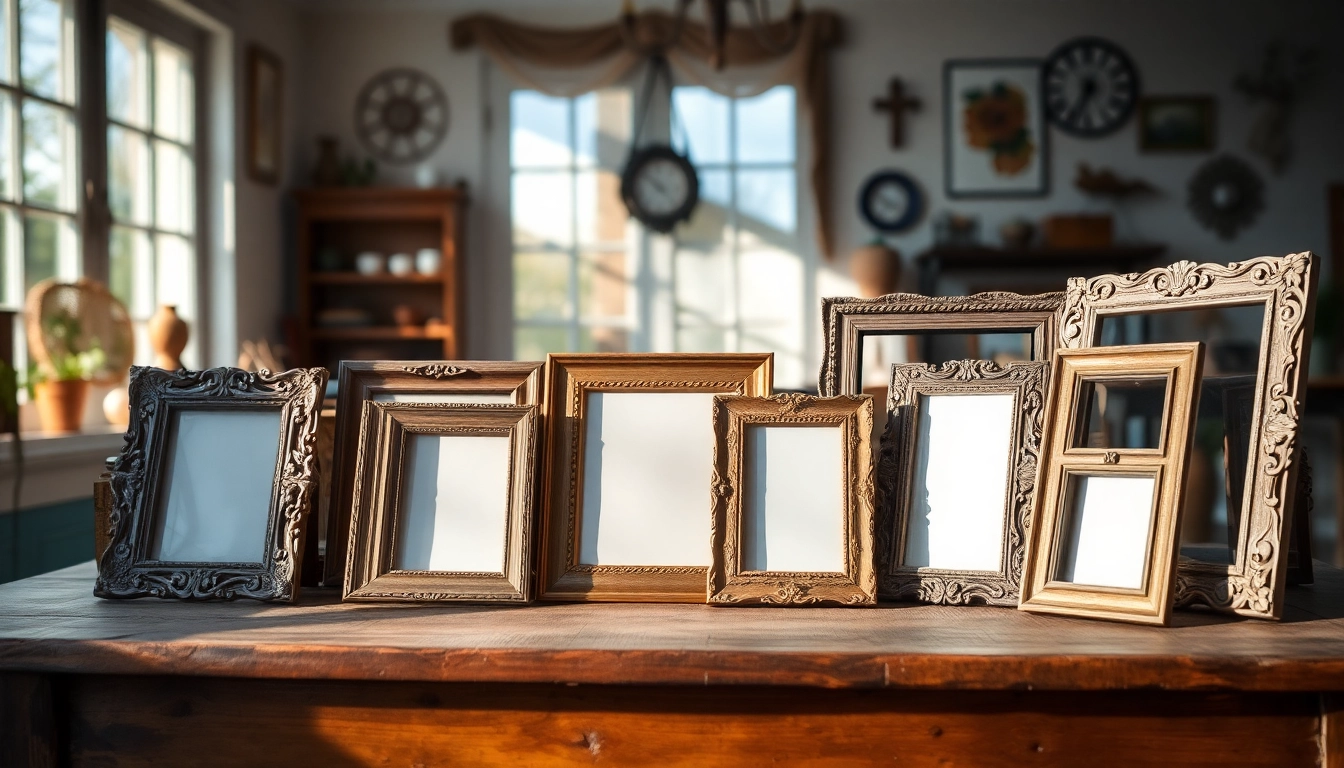The Charm of Vintage Frames
In the realm of decor and personal style, vintage frames hold an irreplaceable spot, thanks to their unique character and timeless appeal. These frames not only encapsulate moments in time but also add dimension and history to any space. As we delve into the world of vintage frames, we discover what makes them so special, their myriad benefits in home decoration, and their role in promoting sustainable design.
Defining Vintage Frames: What Makes Them Unique?
Vintage frames are often characterized by their distinctive designs, craftsmanship, and the stories they carry from the past. Generally defined as frames produced between 20 to 100 years ago, these pieces can span a variety of styles and materials. Most vintage frames are typically made from wood or metal, featuring intricate details that reflect the craftsmanship of their era. Their charm lies in the unique imperfections that often come with age—patinas, minor scratches, or slight warping that give each piece a personality all its own.
Benefits of Using Vintage Frames in Home Decor
Incorporating vintage frames into home decor presents numerous advantages:
- Character and Uniqueness: Vintage frames stand out due to their one-of-a-kind designs and the histories they embody, providing personality and charm that modern frames often lack.
- Versatility: They can be paired with various aesthetics, from bohemian to minimalist, seamlessly blending into different interior styles.
- Color and Texture: Vintage frames often come in varied tones and textures, enhancing a room’s visual interest.
- Storytelling Element: Each frame carries its own story, adding depth and intrigue to your decor.
- Investment in Quality: Many vintage frames are well-crafted, often made from high-quality materials, offering durability and long-lasting appeal.
How Vintage Frames Contribute to Sustainable Design
In an era increasingly focused on sustainability, vintage frames embody a perfect blend of style and eco-consciousness. By choosing vintage, homeowners actively participate in reducing waste and the demand for mass-produced items, therefore minimizing their ecological footprint. Each vintage piece can be considered a form of upcycling, allowing past designs to find new life and purpose. Moreover, it encourages a mindset shift towards valuing quality craftsmanship over consumerist trends.
Types of Vintage Frames
Exploring the eclectic range of vintage frames unveils a collection of styles, materials, and cultural influences from different eras. Understanding these types helps in appreciating the nuances in design and function.
Different Styles: From Ornate to Minimalist Vintage Frames
Vintage frames come in a plethora of styles:
- Ornate Frames: Characterized by intricate carvings and embellishments, these frames, often made of wood, can evoke a sense of grandeur, making them perfect for classical-themed interiors.
- Art Deco Frames: Known for their geometric shapes and bold colors, these frames add a touch of flair reminiscent of the Roaring Twenties.
- Mid-Century Modern Frames: Clean lines and functional designs are the hallmarks of mid-century frames, making them suitable for contemporary spaces while still showcasing vintage charm.
- Industrial Frames: Typically made from metal, these frames are simpler in design and work well in modern, eclectic, or industrial-themed settings.
- Minimalist Frames: Focusing on simplicity, these frames complement spaces with a lighter aesthetic without overshadowing the art they hold.
Material Choices for Vintage Frames: Wood, Metal, and More
Vintage frames are made from various materials, each contributing to their aesthetic and structural qualities:
- Wood: Often used in ornate frames, wood adds warmth and can be stained or painted in numerous finishes.
- Metal: Commonly used in minimalist or industrial frames, metal offers durability and a sleek look.
- Glass: Many vintage frames feature glass fronts, which preserve the art and lend a polished finish.
- Composite Materials: Some frames are made from a mix of materials, capturing a blend of styles.
Popular Eras: A Look at Vintage Frames from the 50s to 70s
Different decades showcase distinctive styles of vintage frames:
- 1950s: This era often highlights pastel colors and floral motifs, with frames that elevate feminine softness.
- 1960s: Bold colors and eclectic designs characterized this era, showcasing a shift toward creativity and experimentation.
- 1970s: Frames became larger and bolder, featuring earth tones and unique geometric shapes, like the infamous butterfly frames which became hugely popular during this decade.
How to Choose the Right Vintage Frames
Finding the perfect vintage frame involves understanding both style and functionality. Here are some guiding principles for making an informed choice.
Tips for Selecting Vintage Frames That Match Your Decor
When selecting vintage frames, consider the following:
- Consider Your Decor Style: Identify your existing interior style—traditional, modern, eclectic—and choose frames that complement it.
- Size Matters: Ensure the frame fits the art you wish to display and suits the intended wall space.
- Color Coordination: Select frames in colors that either contrast or harmonize with your wall colors and decor.
- Functionality: If the frame will serve a functional purpose (like containing a mirror), ensure it meets your practical needs.
Identifying Quality in Vintage Frames: Key Features to Look For
Quality is paramount when selecting vintage frames. Look for signs of craftsmanship such as:
- Materials: Check that the frame is constructed from durable materials; solid wood often denotes higher quality than particle board.
- Joinery: High-quality vintage frames often have sturdy joinery methods, rather than being glued or stapled.
- Finish: Examine the finish for consistency and integrity; chipped or poor finishes can indicate neglect.
- Backing and Hardware: Ensure that the frame’s backing and hooks are intact and properly functional for wall mounting.
Incorporating Vintage Frames into Modern Aesthetics
Blending vintage frames into a modern decor style can create an intriguing juxtaposition that captivates the eye. Here are a few strategies:
- Create a Gallery Wall: Mix vintage frames with modern art pieces to create an eclectic gallery wall.
- Accent Pieces: Use a bold vintage frame against a neutral wall to serve as a focal point without overwhelming contemporary decor.
- Mix and Match: Combine frames of different eras and finishes to create an inviting collage that narrates a visual story.
Displaying Vintage Frames
Displaying vintage frames creatively can enhance their appeal and elevate your decor. Consider the following methods for showcasing them effectively.
Creative Ways to Display Vintage Frames at Home
Your display options can significantly influence the ambiance of a room. Here are some ideas:
- Gallery Wall: Create a dedicated gallery wall by combining various sizes and styles of vintage frames filled with artwork, photos, or mirrors.
- Shelf Displays: Place smaller vintage frames on shelves or mantels alongside books and decorative objects.
- Layering: Layer frames on surfaces or against walls to create depth and interest, allowing glimpses of backing and framing details.
Combining Vintage Frames with Other Decorative Elements
When mingling vintage frames with other decor items, consider these pairings:
- Textiles: Pair frames with bold fabrics—throws, curtains, or cushions—to create a textured effect.
- Natural Elements: Position frames near plants or floral arrangements to infuse a touch of nature into your decor.
- Lighting Effects: Highlight frames with strategically placed lighting that casts interesting shadows and draws attention to intricate detailing.
Seasonal Decor: Refreshing Your Vintage Frame Displays
Updating your vintage frame displays seasonally can keep your decor feeling fresh and engaging:
- Switch Out Artwork: Change the imagery or artwork displayed within the frames according to the seasons.
- Color Coordination: Introduce seasonal colors in your frames by painting them or adding seasonal decor elements for special occasions.
- Holiday Themes: Incorporate seasonal touches, such as autumn leaves or festive motifs, into the displayed art to resonate with the time of year.
Where to Find Vintage Frames
Sourcing vintage frames can be an enjoyable treasure hunt. Here are some of the best places to search:
Top Online Retailers for Vintage Frames
Several online platforms cater specifically to vintage enthusiasts:
- Etsy: A marketplace for unique handmade items and vintage treasures, Etsy boasts an extensive selection of vintage frames from various sellers.
- eBay: A well-known auction platform where vintage frames can be found at competitive prices, often sold by collectors.
- Vintage Frame Company: They specialize in designer vintage eyewear and frames, celebrating styles from the 50s to early 2000s.
- Amazon: A resource for a variety of vintage-style frames as well as antique finds from third-party sellers.
Thrift Shops and Antique Markets: The Hunt for Vintage Frames
Exploring thrift shops and antique markets can yield some hidden gems:
- Local Thrift Stores: Regularly visiting thrift shops can reveal unexpected finds at budget-friendly prices.
- Antique Fairs: These events often host vendors with curated collections of vintage frames.
- Estate Sales: Attending estate sales can be particularly fruitful, often offering high-quality, unique vintage items.
Assessing Value: Are Your Vintage Frames Valuable?
To determine the value of vintage frames, several factors come into play:
- Rarity: Limited edition pieces from notable designers or eras are typically more valuable.
- Condition: Well-preserved frames with minimal wear hold greater value.
- Provenance: Knowing the history and previous ownership can enhance a frame’s value, particularly if it belonged to a notable figure.
- Market Demand: Monitoring current trends and collectors’ interests can also inform the value and desirability of specific vintage frames.




